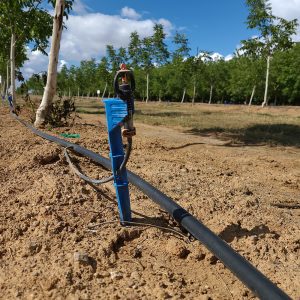
Water is a precious and sometimes scarce resource. In California, a state which comprises large arid and semi-arid regions, the role of water as a key cog in the wheel of economic development is an ever-present topic to various stakeholders. Although 2023 has been an unusually wet year to the extent that most of the state has been declared “drought free,” memories of recent drought periods are still fresh in the minds of many Californians, especially growers. Despite the aridity, California’s Mediterranean-type climate makes it suitable for year-round production of certain crops, especially vegetables, in addition to summer crops such as nuts and fruits for which it is well known.
The main limiting factor to crop production in a semi or arid environment, is water for irrigation, and in California, this is addressed through surface and groundwater resources. In the Central Valley, the surface water needed to sustain irrigation is transported from the Sacramento-San Joaquin Delta through a system of aqueducts, such as the Statewide Project which supplies about 34% of water for agriculture, and Friant Canal which provides water to irrigate about a million acres of cropland. However, being a drought-prone region, sometimes surface water resources become very limited or even unavailable due to little precipitation. Over the years, growers have had to heavily rely on groundwater during drought periods, and the cumulative effect of such withdrawals is manifested in markedly reduced aquifer water levels in some areas. In response, there are efforts to conserve and restore some of these severely stressed aquifers, and a major endeavor to this regard is the landmark Sustainable Groundwater Management Act (SGMA) passed by the California legislature in 2014. SGMA’s goal is to guide the process of restoring the Central Valley aquifers by the early 2040s. One of the major implications of this is potentially significant reductions in amount of water available for irrigation. Faced with this prospect, it is important to further explore opportunities that exist in technologies and management approaches that can help improve irrigation efficiency. Efficient irrigation systems are basically technologies coupled with management approaches that primarily ensure the least water loss, possibly savings in energy and other operation and management costs.
Practices Advance Over Time
Irrigation in the western U.S. has undergone monumental changes from the earliest beginnings where gravity flow systems, or surface irrigation, based on water diversions from regional rivers and streams, or land reclamation through drainage, facilitated the establishment of irrigated farms. This approach to crop watering remained the most common method of irrigation until about the 1970s. In the peak era of gravity flow systems, there was not a lot of worry about irrigation efficiency, and efforts focused on how to cost-effectively harness water and apply it to crop fields. In a gravity flow system, a waterfront advances down a gentle gradient, ranging from 0.1% to 3% depending on method, thus gradually wetting the field. Because of this, the highest points where water application begins usually end up being overwatered in comparison to the lowest end. The severity of such non-uniformity is dependent on soil type, field conditions and other irrigation management factors. Gravity flow systems typically have irrigation efficiencies ranging from 50% to 60% but values greater than this are attainable in modern and well managed schemes.
The next leap in irrigation practice and technology was the development of pressured irrigation, specifically sprinklers in the last century, which made it relatively easier to apply water more uniformly across fields in comparison to gravity flow systems. To this end, the invention of the precursor of the modern center-pivot by Frank Zybach between 1948 and 1952 was a watershed moment. Not only did center-pivot irrigation markedly help improve irrigation efficiency, it also addressed to a large extent some of the labor challenges of operating fixed-set and hand-move sprinklers. The first-generation center-pivots used high-pressure impact sprinklers operated at 70 to 100 PSI and high flow rates. The defining characteristic of a center-pivot irrigation system is its ability to propel itself across a circular path in the field while in operation, thereby enabling large fields to be irrigated using a few sprinklers. In traditional fixed-set sprinkler irrigation, usually a dense network of sprinklers has to be installed in order to cover the field. Another variation of self-propelling irrigation systems is the linear-move sprinkler set, which in operation advances from one end of a field to the other in a straight line; after which it reverses direction to return to its start point. When well designed and managed, sprinkler irrigation systems can attain irrigation efficiencies as high as 70% to 85%. Today, center-pivot and linear move irrigation is popular in the U.S. and is picking up in some regions of the world. Modern units are fitted with low-pressure nozzles and can attain irrigation efficiencies as high as 90% when operated effectively.

A further improvement on pressurized irrigation is a class of devices collectively known as microirrigation systems. These typically include drip irrigation (surface, subsurface and button) and microsprinklers (or sprays). The higher irrigation efficiency of microirrigation systems is attributed to the fact that they are designed to apply water to only a fraction (33% to 60%) of the field. Usually, this is the immediate area near the base of the plant where there is likely to be the highest root density. They are particularly well suited to situations where crops are largely space, such as in orchards, and therefore irrigation should be limited to the root zone. When properly designed and managed, microirrigation systems can attain irrigation efficiencies above 90%. Of these, drip systems are known to be the most efficient. The most water-efficient form of drip is subsurface drip (SDI) which can attain irrigation efficiencies higher than 95%. In SDI the driplines are buried at depths usually ranging from 1 to 24 inches which significantly reduces evaporative water losses. In California, as much as 60% of processing tomatoes are grown using SDI.
Management in the Current Year
For a grower, many considerations go into the choice of an irrigation method in order to optimize profitability. Today, faced with competing water demands from other sectors coupled with supply uncertainty in some years, the question of irrigation efficiency is arguably one of the major issues that growers have to think about in their operations. A basic question to this end relates to how additional water savings can be attained through improved irrigation efficiency, and what it would take to make the transition for individual growers? A further question would be how sustainable crop production would be, even when using the most efficient irrigation methods under very stringent water availability conditions?
The most efficient irrigation methods usually have the highest capital costs, and this is usually the main constraint to adoption for some growers. This particularly used to be the case in the early years of microirrigation, but today, costs are relatively competitive when compared to other methods.
It is important to stress the point that even the most efficient irrigation methods are only as efficient as the overall management approach. Therefore, addressing any water loss pathways in an irrigation system is usually among the first things an irrigation manager should do. The integration of traditional irrigation management with modern tools such as electronic soil and plant sensors and information technology platforms is currently undergoing rapid growth in the U.S. and some areas of the world. Technologies such as variable rate irrigation (VRI) for center-pivots and linear-move systems, or remote zone control in largescale fixed set irrigation systems have advanced the feasibility of precision irrigation and with-it higher irrigation efficiencies.
In the last 40 years across the U.S., the amount of water used for irrigation has dropped from about 1.8 to 1.5 acre-feet per irrigated acre; roughly 17%. In the same period, the irrigated acreage increased from about 50 to 60 million acres. This could be attributed to a combination of factors such as the increased adoption of more efficient irrigation methods and the expansion of supplemental irrigation to the more humid eastern regions of the country. In a nutshell, more cropland is being irrigated with less water, which in the grand scheme of things is a step in the right direction. A growing world population means more food has to be produced under more constraining conditions, and irrigation efficiency is one of the tools to realizing this.










